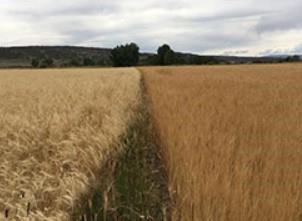By Karl Hoppe
Bale grazing is an alternative method for feeding the cow herd in the winter, when snow is too deep for cows to graze grass, cover crops, or crop residue, or additional or replacement feed is required.

Traditionally, a tractor/loader, feed wagon, and bale shredder are used to process and delivery feed to cattle herds during the winter. With equipment costs and fuel costs increasing, some producers are seeking alternative feeding methods.
One option is to let cattle walk to the feed instead of using a tractor to haul feed to cattle.
Round bales of hay need to be strategically placed in a field in the fall, in rows 20 to 50 feet apart. During the winter cattle are given access to three to four days or even a week’s worth of feed at one time. The bales to be fed are separated from the rest of the bales by a movable electric fence.
Rather than placing the electric fence posts in frozen ground, electric fence posts are pushed into the sides of the adjoining row of bales. Two fence wire runs are sufficient, and the wire is “leap-frogged” to the next set of bales as needed.
A tractor is not necessary unless snow drifts are limiting the herd access between their shelter and bales.
The summer I visited a ranch that received a USDA-SARE Farmer and Rancher Grant to explore bale grazing. They looked at the effects that bale grazing has on soil health and fertility, and found an improvement in soil fertility where the bales were placed. Nitrate nitrogen levels in the soil were 74 pounds per acre where the bales were fed, compared to 4 pounds where bales were not fed.
In a subsequent SARE Farmer and Rancher Grant, the ranchers successfully used multiple species (cattle and sheep) for winter bale grazing. Soil health was improved where the bales were fed and in a 20-foot radius around the bale site. The difference in soil health remains is visible for several years.
Source : ndsu.edu